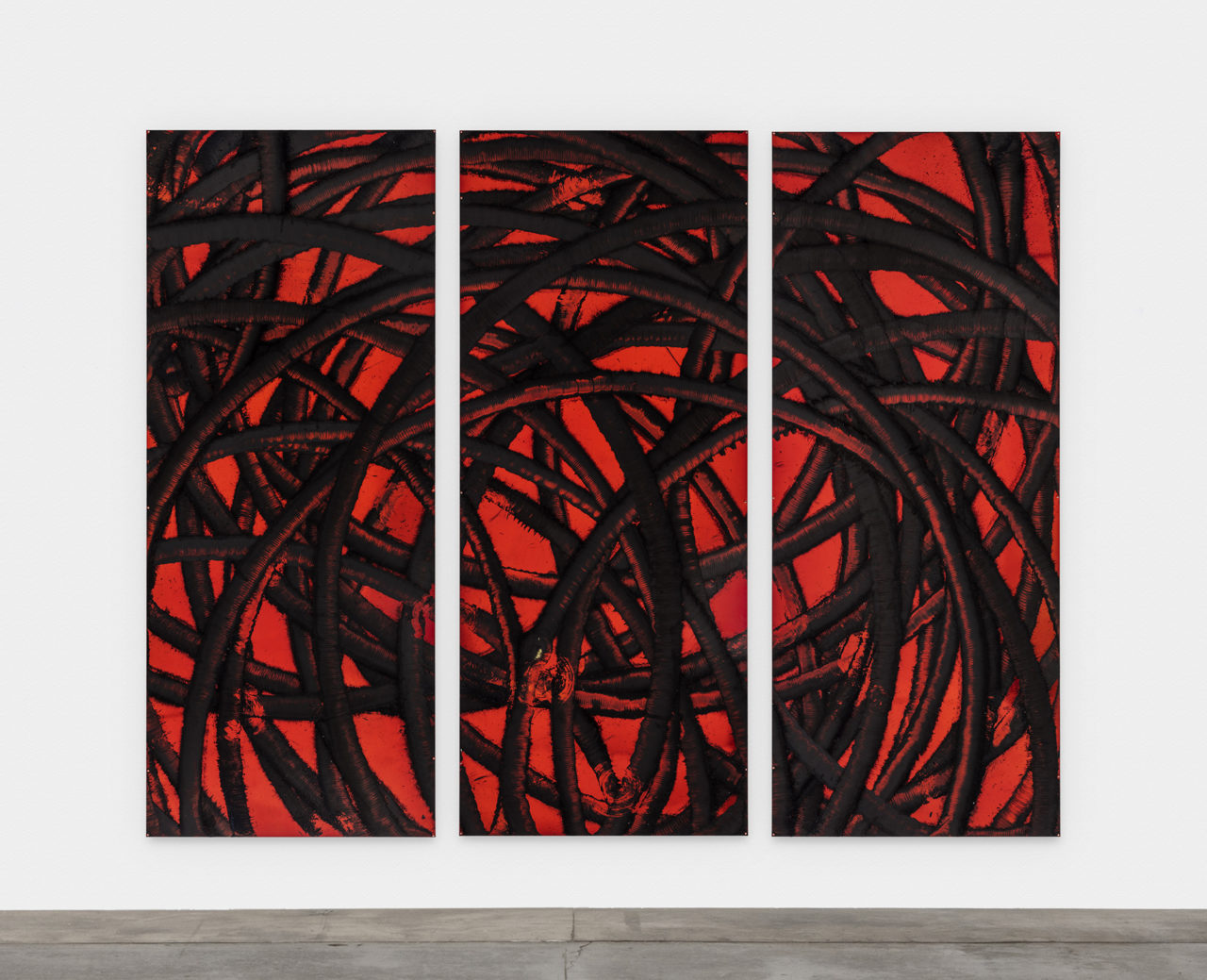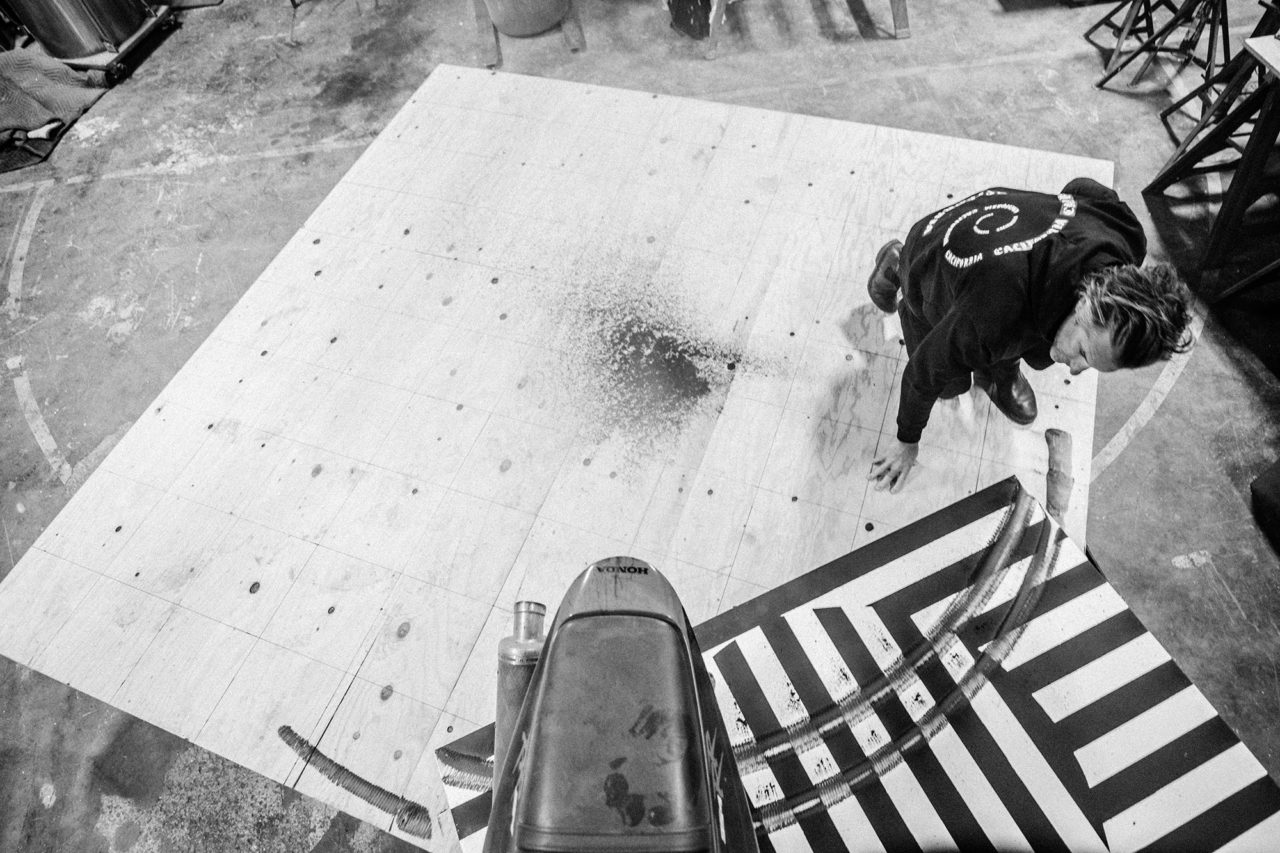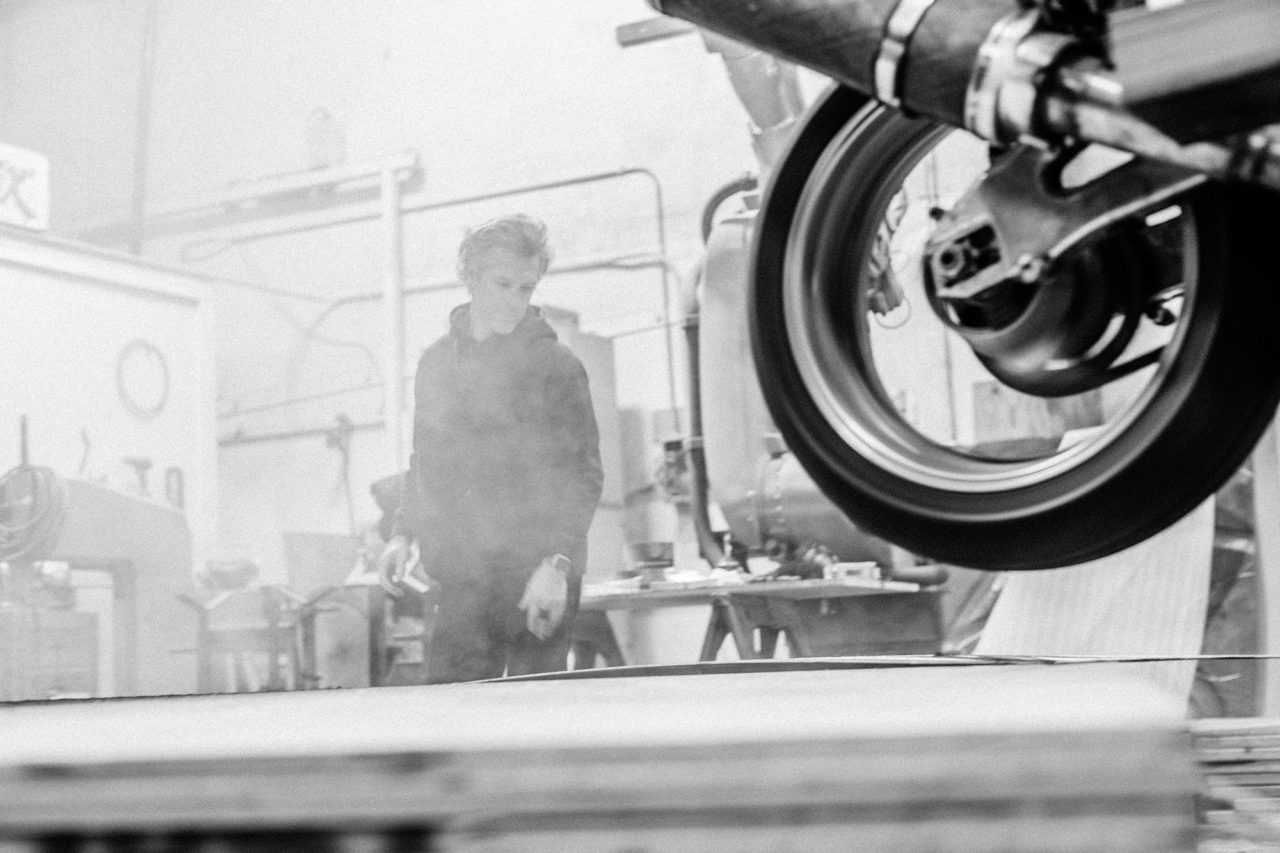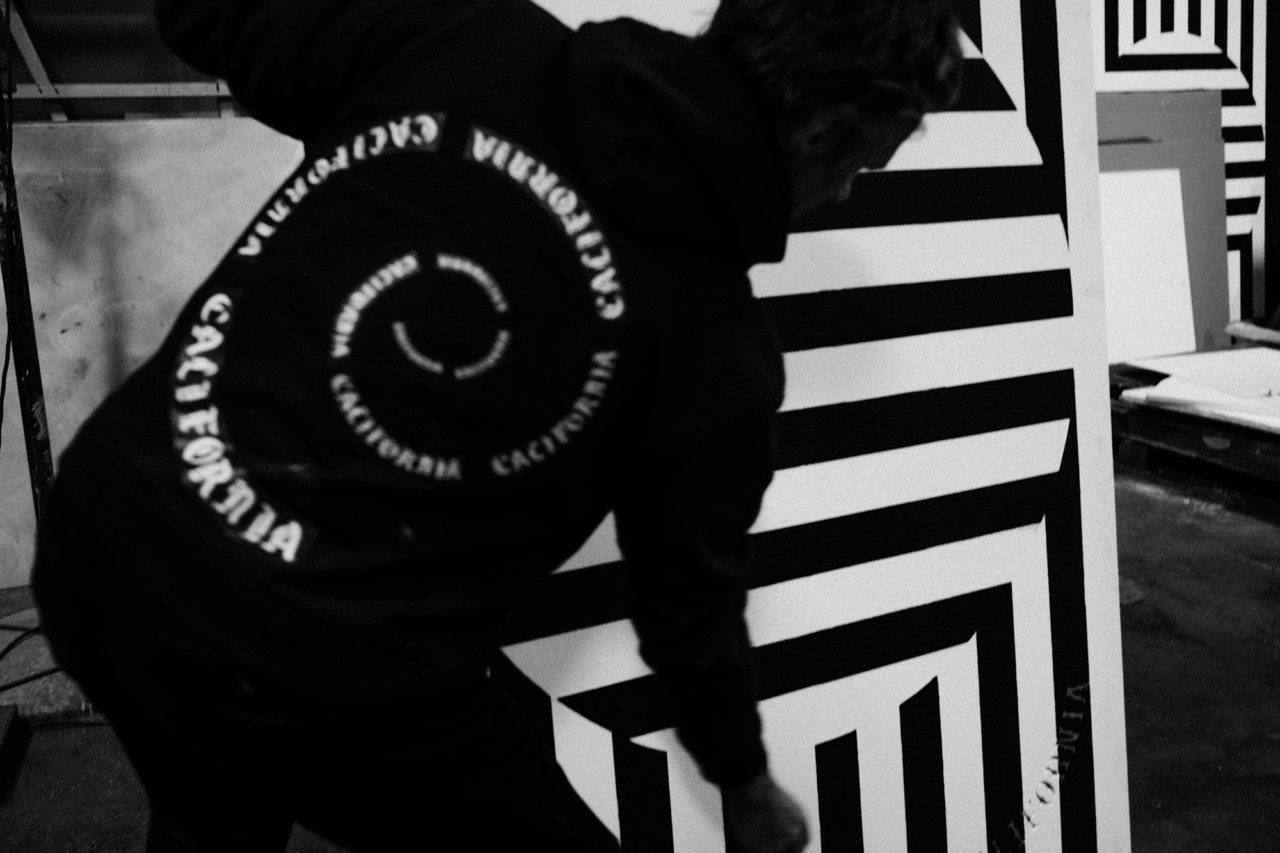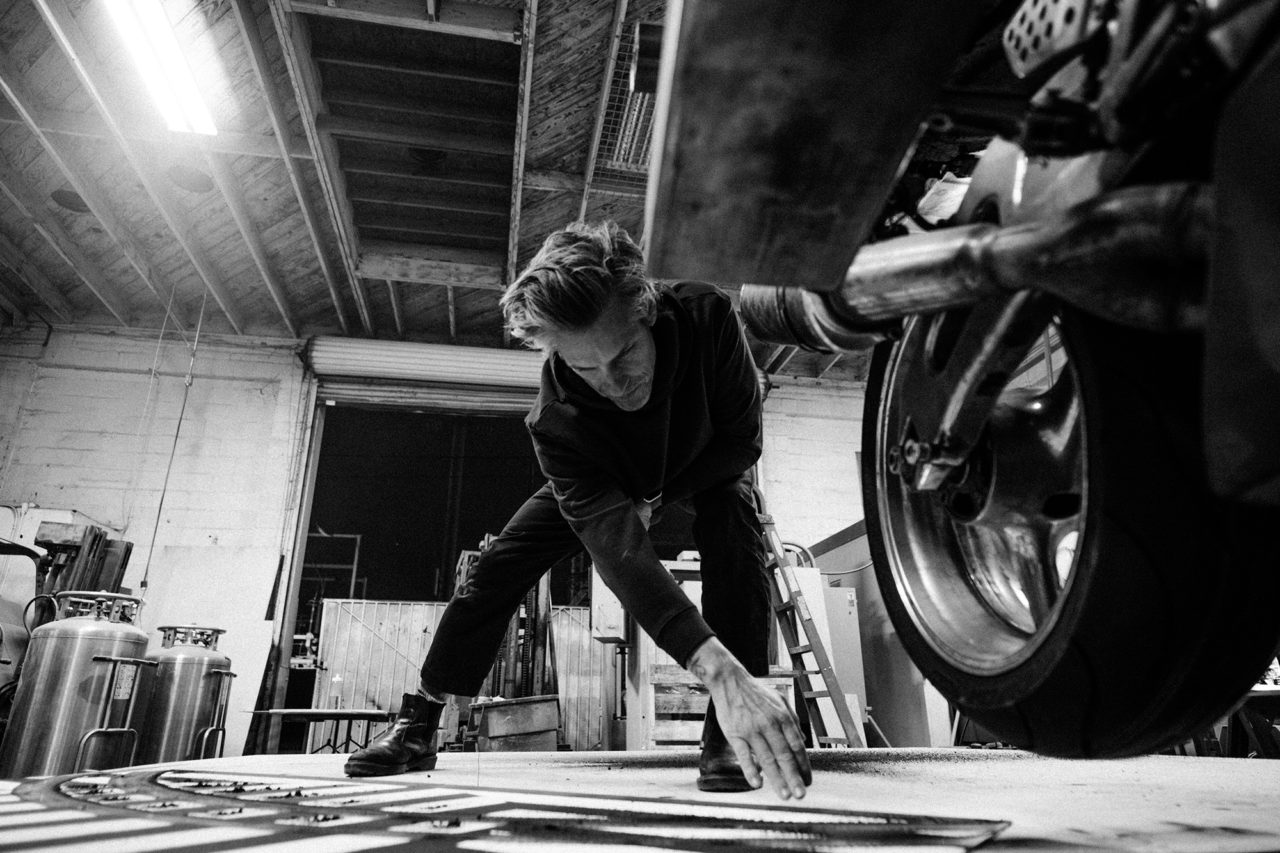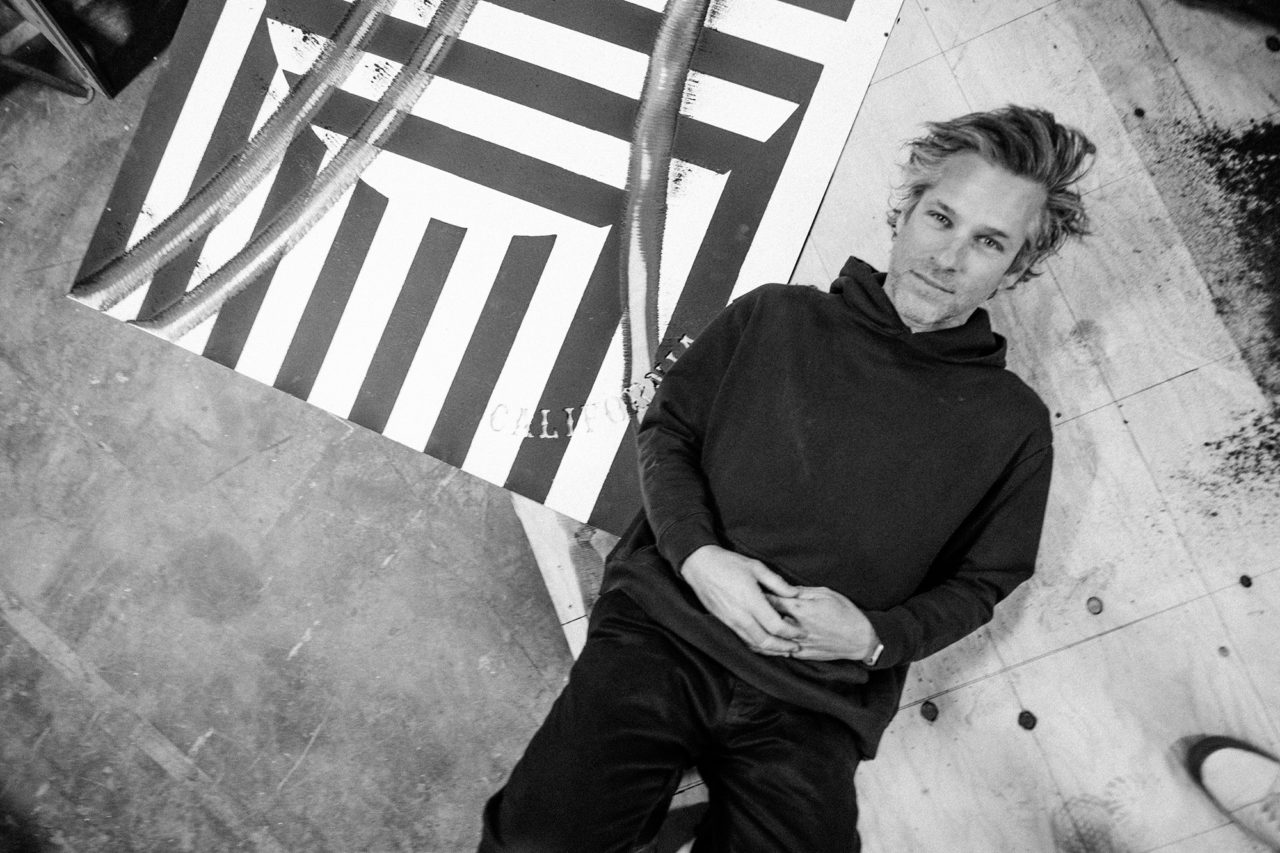C catches up with the contemporary artist on the eve of the debut of “The Right Way to Do Wrong” at the UTA Artist Space
C Magazine

If you lived in the Salinas area in the mid- to late-’80s and remember having your car keyed, it may have been the handiwork of contemporary artist Aaron Young. The precocious youngster channeled his creative energy as a student at the San Francisco Art Institute and then received an MFA from Yale before moving to New York where he’s spent the last two decades establishing his signature brand of elegant yet aggressive artistry that has turned him into a household name. In one of his most celebrated works, Greeting Card 10a, 2007, Young and his assistants drove motorcycles over plywood panels, “painting” them with exhaust smoke and tire tracks. His pieces have been snapped up by esteemed private collectors and museums such as The Museum of Modern Art in New York, the Los Angeles County Museum of Art and Museo Jumex in Mexico City, among others.
Photo by Charles White.
But California’s native son was destined to return West. Two years ago, Young moved to Los Angeles with his wife, Laure Hériarld Dubrield — the chic French fashion proprietor of The Webster boutiques — and their two young children. Now, he is set to open his first West Coast show in over ten years entitled “The Right Way to Do Wrong” (not to be confused with his 2010 exhibit at Gagosian Gallery of the same name; read on for further explanation). Twice delayed because of Covid, the much-anticipated show at the UTA Artist Space gallery in Beverly Hills is a riotous blend of old work and new: there are hallucinogenic California wheels, “Karen” printed against an ominous black background, rocks graffitied with “Locals” and “Go Home!”, gilded 24-karat tents and Houdini-esque trickery where the vision of a work only manifests during a retinal burn. Of course, Young’s penchant for car culture has never been more assuaged, with new motorcycle pieces and even some “keyed” car pieces — only this time, the meticulous works (inspired by Lucio Fontana’s cut canvases) would make any Angeleno on the road happy to be the subject of such vandalism.
We caught up with the man of the hour in the midst of installing the new show to shed light on all the things he’s doing wrong.
“Coming back to California, I had a lot of ideas”
AARON YOUNG
Photo by Josh Rose.
C Magazine: How’s the install going?
Aaron Young: It’s going good. It’s really nice to see some of the work that I haven’t seen in a while because I’ve been away in New York for 20 years. They’ve been traveling in my backpack for a long time.
C: You’re not serious?
AY: No, no, they’ve gone from studio to studio.
C: Looking at all of the pieces together, would someone be able to tell if they were made in New York or in California?
AY: These last two years being back in Los Angeles have kind of opened up different spaces for me within my own practice. I don’t really think that I could have made a lot of these works in New York.
C: Do you mean physical space?
AY: Physical space, yes. I’m able to work in a bigger studio and there are more toys to play with and materials to process. Yeah. But you know I’m also being inspired by the kind of custom paint culture here. Also being able to work with fabricators like Landon Ryan. We had long conversations about motorcycle painting and I told him I’m not going to make more, unless I can be completely precise and I can put it on a single panel because I’ve never been able to do that. And the first thing that he said to me was, ‘Well, let’s get rid of the rider.’
Photo by Josh Rose.
C: How do you do the motorcycle works without a rider now?
AY: So instead of the bike moving around, it’s completely stable. We basically created a Lazy Susan platform that we secured the panel to, and the platform spins rather than the bike. We completely reverse-engineered it. It’s much more precise, but we do have accidents.
C: Such as?
AY: Oh, well, when a tire blows and it just starts slapping hot rubber all over your piece and it looks way better. It’s only happened to me three times.
C: Did one of those make it in the show?
AY: Yeah. It’s called Perfect Lovers.
C: So, this technique is something that you’re showing for the first time?
AY: Yeah. Coming back to California, I had a lot of ideas. There’s a series of aluminum paintings painted with automotive paint and polished, like a car hood. Then they are keyed, but in the style of a Lucio Fontana cut piece.
Photo by Josh Rose.
C: Seems like you are fully embracing L.A.’s car culture.
AY: Yeah. I mean, anything in this show could be [the result of] me walking down the street and recognizing something and then filtering it through my art history. Like when I see a car keyed, I think of Fontana’s cut.
C: Has your car ever been keyed in real life?
AY: [Laughs] I think I’ve done it a couple of times in high school.
C: So, you have experience?
AY: The thing is that people do that for so many different reasons, right? It’s mark making, it’s an, ‘I was here,’ it’s out of anger, it’s graffiti… It’s many, many different types of expressions through that kind of mark making. It all kind of like comes back to something that cannot be expressed in words.
“This entire show is trying to peel the surface off”
AARON YOUNG
C: That’s interesting. It is like leaving a calling card in a way…
AY: What I’m trying to do is to find this tension between something very elegant, but also something very aggressive.
C: I wanted to ask you about the name of the exhibit, “The Right Way to Do Wrong.” It’s curiously the same title as your 2010 show at the Gagosian?
AY: Well, I really like this title. I wish I could use it for every show that I do.
C: It does have a nice ring to it.
AY: You know, using the same title again is wrong. You don’t do that. Which is why it makes sense to me.
Photo by Josh Rose.
C: That’s funny.
AY: I got the title from the name of a magazine, but now it’s become a hardcover book by Harry Houdini. It’s about all the places that he traveled and people he interviewed: pick pockets, thieves, all kinds of desperate characters. And he detailed how they did their tricks.
C: Are you focusing on this idea of perception and reality in the show?
AY: Well, I just hope that it will be able to open up the envelope. This entire show is trying to peel something, peel the surface off. There’s a piece called Family and it’s three domed tents, but just the architecture of the tents. And they’re right on top of each other, like baby tent, mama tent, papa tent, and they’re plated in 24-karat gold. I thought that Family was the perfect title for this because inside of a family, you do create your own tribe, your own belief systems, your own values, structure, protection, your own exposure to the world. Yeah. That’s kind of the center of a lot of the show.
C: Could you have made that piece 10 years ago when you didn’t have kids or weren’t married?
AY: Well, it is also site-specific for Los Angeles. All you see are tents… I’m not trying to make a gold tent. It’s a reference point to the real world. And not putting any nylon on it — you’re fully exposed. So, all of these things you see just driving around Los Angeles. Basically, I see something and then I will just kind of take that as the first part of the puzzle. And then I start to put it together in my own knowledge of art history, my own practice, my everyday life, my family, things like that. And then I kind of build the architecture of the idea.
Photo by Josh Rose.
C: The last time we spoke you were triangulating between Point Dume, where you love to surf on the weekends, Beverly Hills Monday through Friday-ish and your studio Downtown.
AY: Yeah, and you know, because my Parisian wife does not drive, I’m also a part-time chauffeur.
C: Do you think that she’ll ever learn to drive, or do you think that she prefers it this way?
AY: I told her, ‘If I make money from the show, I’ll get you a black Porsche.’ Maybe that will get her to drive.
Feature image: Photo by Josh Rose.
